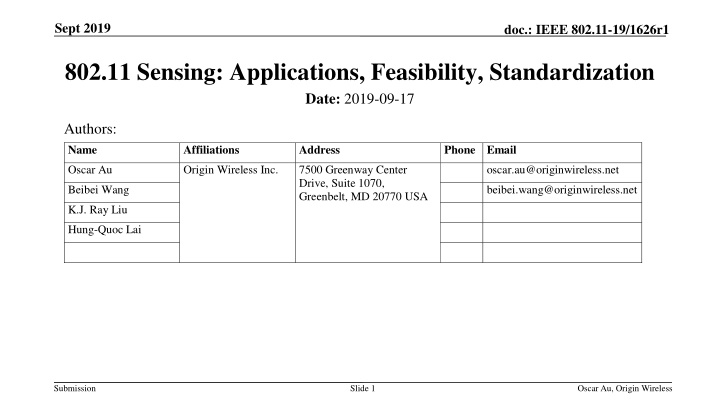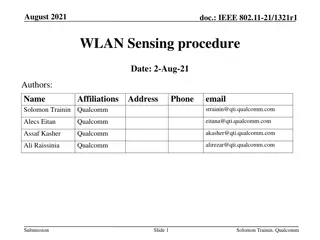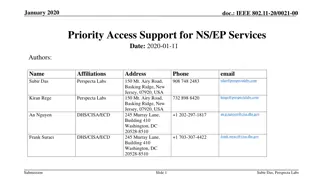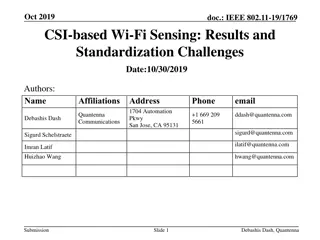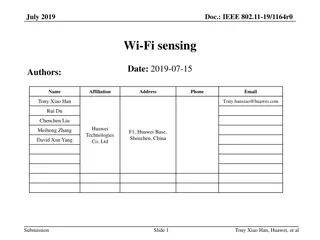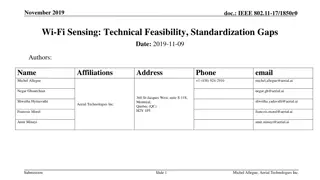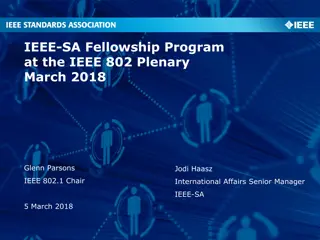IEEE 802.11 Sensing: Applications, Feasibility, Standardization
IEEE 802.11 sensing, also known as WiFi sensing, utilizes 802.11 signals to detect changes in the environment through signal processing and machine learning. This technology offers various advantages over common sensors, such as motion detection, breathing monitoring, and tracking, without the need for line-of-sight or wearables. The potential for standardization in 802.11 sensing opens up new opportunities for industries and devices compliant with the 802.11 standard.
Download Presentation

Please find below an Image/Link to download the presentation.
The content on the website is provided AS IS for your information and personal use only. It may not be sold, licensed, or shared on other websites without obtaining consent from the author.If you encounter any issues during the download, it is possible that the publisher has removed the file from their server.
You are allowed to download the files provided on this website for personal or commercial use, subject to the condition that they are used lawfully. All files are the property of their respective owners.
The content on the website is provided AS IS for your information and personal use only. It may not be sold, licensed, or shared on other websites without obtaining consent from the author.
E N D
Presentation Transcript
Sept 2019 doc.: IEEE 802.11-19/1626r1 802.11 Sensing: Applications, Feasibility, Standardization Date: 2019-09-17 Authors: Name Affiliations Address Phone Email Oscar Au Origin Wireless Inc. 7500 Greenway Center Drive, Suite 1070, Greenbelt, MD 20770 USA oscar.au@originwireless.net Beibei Wang beibei.wang@originwireless.net K.J. Ray Liu Hung-Quoc Lai Submission Slide 1 Oscar Au, Origin Wireless
Sept 2019 doc.: IEEE 802.11-19/1626r1 Outline An Introduction to 802.11 sensing Why 802.11 sensing? Advantages of 802.11 sensing over some common sensors Functionality and applications of 802.11 sensing Business opportunities of 802.11 sensing Feasibility of 802.11 sensing: motion detection, breathing monitoring, tracking Need of standardization for 802.11 sensing Conclusion References Submission Slide 2 Oscar Au, Origin Wireless
Sept 2019 doc.: IEEE 802.11-19/1626r1 Introduction to 802.11 sensing (WiFi sensing) 802.11 sensing, or WiFi sensing, [1] is the use of 802.11 signals to sense (e.g. detect) events/changes in the environment. Often with signal processing and machine learning. A STA (Tx) transmits 802.11 signal to a STA (Rx) in a multipath-rich venue. 802.11 signal bounces back and forth in the venue generating lots of multipaths. Although undesirable to communications, the bouncing of the 802.11 signal effectively scan or sense the venue. By monitoring the multipaths (e.g. through CSI [10], see slide 11), it is possible to detect target events and changes in the venue. Example in next slides. Line-of-sight (LOS) not required. Work in both LOS and Non-LOS (NLOS). Wearable not required in most applications. Submission Slide 3 Oscar Au, Origin Wireless
Sept 2019 doc.: IEEE 802.11-19/1626r1 Why 802.11 sensing? New way to sense. New functionalities for 802.11-enabled devices (TV, speaker, router, IoT devices) and facilities (stadiums, halls, rooms, warehouse, factory). New industry-wide business opportunities for all 802.11 related companies (components/ devices/services). See slide 7. Performance advantages over existing sensors. (see next slide) NLOS operation. No blind spot. Especially suitable for indoor. Ubiquitous. 802.11-enabled devices popular in homes/office. Any device compliant with the 802.11 standard potentially could be used. Need no dedicated hardware. Any 802.11-compliant device (including our demo devices) can potentially implement any 802.11 sensing functionalities using only software upgrade. Submission Slide 4 Oscar Au, Origin Wireless
Sept 2019 doc.: IEEE 802.11-19/1626r1 Advantages of 802.11 sensing over some common sensors 802.11 sensing both LOS/NLOS Need 1 Tx/Rx pair to cover a house learning Passive infra-red (PIR) motion sensor LOS only Need many (e.g. 6) to cover a house no learning Video camera: video intrude privacy LOS only memory intensive computation intensive no video to intrude privacy both LOS/NLOS much lower storage requirement much lower computation requirement Submission Slide 5 Oscar Au, Origin Wireless
Sept 2019 doc.: IEEE 802.11-19/1626r1 Functionalities/applications of 802.11 sensing Motion detection [2] (NLOS)* # intruder detection, security, smart IoT Breathing monitoring [3] (wearable-free)* # sleep monitoring, well-being, caregiving Locationing/tracking [4] (NLOS)* smart factory, indoor GPS companion, traffic planning Fall detection [5] (no video)* # older adults, accident detection, caregiving Child detection in hot cars * # smart cars, accident prevention Presence/proximity detection [6]* # conference room, convenience, smart IoT Human identification [7]* # user identification, personalization, smart IoT Gesture recognition [8] # smart office Activity recognition [9] # user interface * Demonstratable. # Contactless/need no wearable. N.B. See [1] for a comprehensive survey. Submission Slide 6 Oscar Au, Origin Wireless
Sept 2019 doc.: IEEE 802.11-19/1626r1 Business opportunities of 802.11 sensing Service providers: New sensing/sensor => new service/new device New wave of 802.11 sensing services regarding daily living, safety, lifestyle, convenience, personalization, caregiving, digital health, etc. Traditional (e.g. broadband, mobile, streaming, cable) or new (e.g. smart device makers) Device manufacturers (e.g. smart home/IoT devices, consumer electronics, computing devices, home appliance, lighting, accessories) New sensing=> new functionality of 802.11-enabled devices New wave of 802.11 sensing devices - DIY or connected to 802.11 sensing service Component providers Backward compatibility => Expanded markets for existing components (firmware upgrade) New component opportunity for 802.11 sensing services and devices Submission Slide 7 Oscar Au, Origin Wireless
Sept 2019 doc.: IEEE 802.11-19/1626r1 Feasibility of 802.11 - Motion Detection In a long-term side-by-side comparison with PIR (a test house covered by 6 professionally installed PIRs and a pair of 802.11 Tx/Rx), 802.11 motion sensing prototype performs similar to, if not better than, the PIRs. Results verified by video recording. Detection rate: 802=99.997%, PIR=97.5% False alarm rate: 802=0.000%, PIR=0.000% Missed detection by PIR PIRx6 802.11 Submission Slide 8 Oscar Au, Origin Wireless Missed detection by 802
Sept 2019 doc.: IEEE 802.11-19/1626r1 Feasibility of 802.11 - Breathing Monitoring In multi-night side-by-side comparison with other breathing sensors (pressure sensor, radar sensor, with polysomnography (PSG) being ground truth), 802.11 breathing monitoring prototype (contactless) outperforms pressure sensor and radar sensor. stage (awake/REM/NREM) detection rate: 802=0.87/0.87/0.89, pressure=0.77/0.46/0.75, radar=0.53/0.79/0.87 median (abs) error: 802=0.47/0.68/0.42bpm, pressure=0.86/1.28/0.80bpm PSG Tx Rx ECG EEG EM G Airflo w O2 Saturation and Hear Oscar Au, Origin Wireless Rate Submission Slide 9
Sept 2019 doc.: IEEE 802.11-19/1626r1 Feasibility of 802.11 Locationing/Tracking In walking experiment along paths in buildings, 802.11 tracking prototype shows high tracking accuracy. Average (abs) tracking error is less than 20-30 cm NLOS operation. Need map. Tx Rx True path 802.11 tracking Submission Slide 10 Oscar Au, Origin Wireless
Sept 2019 doc.: IEEE 802.11-19/1626r1 Need of standardization for 802.11 sensing As said before, the bouncing of 802.11 signals creates multipaths which effectively scan or sense the environment - including any object motions, events and changes. The multipaths are captured in channel state information (CSI) [10]. In 802.11 sensing, various signal processing/machine learning algorithms and systems are applied to obtain and analyze CSI to achieve various tasks, regarding motions/events/changes. E.g. Motion detection by detecting change in CSI E.g. Breathing detection by detecting cyclic behavior of CSI E.g. Locationing by CSI recognition. While standardization of the algorithms may not be needed, standardization may be needed for the systems regarding CSI generation, timing, accuracy, consistency, protocol, etc. Interface may need to be standardized. (WiFi Alliance?? TBD.) Some 802.11 sensing demos need periodic probing/CSI generation at 1/10/100/1000Hz? Submission Slide 11 Oscar Au, Origin Wireless
Sept 2019 doc.: IEEE 802.11-19/1626r1 Need of standardization for 802.11 sensing Need a protocol to control the generation of CSI, repetition rate, accuracy of timing, antenna selection and probing for 802.11 sensing. CSI consistency, precision and format may be needed. (WiFi Alliance? TBD.) Some current challenges: CSI is not always available. CSI sufficient for data communication may not be sufficient for 802.11 sensing. CSI sufficient for a 802.11 sensing task may be insufficient for another. No standardized testing for CSI for 802.11 sensing: consistency, accuracy, precision. (WiFi Alliance? TBD.) Submission Slide 12 Oscar Au, Origin Wireless
Sept 2019 doc.: IEEE 802.11-19/1626r1 Conclusion A checklist of criteria for standard development Broad market potential - Yes Distinct identity Yes Technical feasibility - Yes Economic feasibility Yes Compatibility with existing 802 standards - Yes Co-existence - Yes Recommendation: 802.11 to form Study Group on 802.11 sensing. Submission Slide 13 Oscar Au, Origin Wireless
Sept 2019 doc.: IEEE 802.11-19/1626r1 References 1. B.B Wang, Q.Y. Xu, C. Chen, F. Zhang, and K.J.R. Liu, "The Promise of Radio Analytics: A Future Paradigm for Wireless Positioning, Tracking, and Sensing", IEEE Signal Processing Magazine, Vol. 35, No. 3, pp.59-80, May 2018. Yu Gu, et.al., MoSense: An RF-based Motion Detection System via Off-the-Shelf WiFi Devices , IEEE Internet of Things Journal, Vol. 4, No. 6, pp.2326-2341, Dec. 2017. Xuefeng Liu, et.al., Contactless respiration monitoring via off-the-shelf WiFi devices , IEEE Trans. On Mobile Computing, Vol. 15, No. 10, pp.2466-2479, Oct. 2016. Feng Zhang, et.al., WiSpeed: A statistical electromagnetic approach for device-free indoor speed estimation , IEEE Internet of things Journal, Vol.5, No. 3, pp.2163-2177, Jun. 2018. Hao Wang, et.al., RT-Fall: A real-time and contactless fall detection system with commodity WiFi devices , IEEE Trans. On Mobile Computing, Vol. 16, No. 2, pp. 511-526, Feb. 2017. Hai Zhu, et.al., R-TTWD: Robust device-free through-the-wall detection of moving human with WiFi , IEEE Journal on Selected Areas in Communications, Vol. 35, No. 5, pp. 1090-1103, May 2017. Hongbo Liu, et.al., Authenticating users through fine-grained channel information , IEEE Trans. On Mobile Computing, Vol. 17, No. 2, pp. 251-264, Feb. 2018. Kamran Ali, et.al., Recognizing keystrokes using WiFi devices , IEEE Journal on Selected Areas in Communications, Vol. 35, No. 5, pp. 1175-1190, May 2017. Yi Wang, et.al., Robust indoor human activity recognition using wireless signals , Sensors, Vol. 15, No. 7, pp. 17195-17208, Jul. 2015. IEEE Std 802.11-2016, Section 19.3.12, pp. 2392-2400. 2. 3. 4. 5. 6. 7. 8. 9. 10. Submission Slide 14 Oscar Au, Origin Wireless
Sept 2019 doc.: IEEE 802.11-19/1626r1 Straw Poll We agree that 802.11 should form a Study Group (SG) on 802.11 sensing. YES NO NEED MORE INFORMATION/TIME ABSTAINED Submission Slide 15 Oscar Au, Origin Wireless
